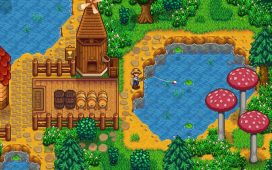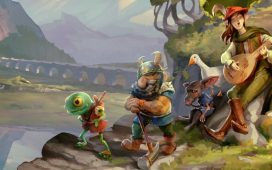Streaming has proved to be one of the most disruptive technologies to hit the media landscape in the last decade. Instant, fuss-free access to movies, TV shows and music has fundamentally changed the way we watch and listen – and if Google gets its way, streaming will transform the way we play too. Today, the firm reveals itself as a new platform holder, announcing a bespoke cloud gaming system that possesses undoubted strengths – and weaknesses – compared to the current console model. Fully integrated with YouTube, and leveraging the unique strengths of its vast, worldwide infrastructure, the new system – named Stadia – has the potential to change everything.
In this extensive interview, I had the chance to sit down with Google VPs Phil Harrison and Majd Bakar, to discuss the principles of Stadia, how it integrates with YouTube, and why it may deliver the opportunity for a genuine shift in the kinds of games we play – innovations only possible with datacentre-based hardware. On top of that, we discuss what differentiates Stadia from Project xCloud – Microsoft’s Xbox One-based streaming set-up – and we also discuss specs in depth, with Google revealing what kind of hardware developers have to work with and how the firm is seeking to remove compute limits.
And then there’s client-side hardware. Google isn’t making a console, there will be no local box that sits under your TV, and it has no intention of adhering to the traditional concept of a console generation – but there will be a new controller, providing some intriguing new features and built for optimal performance on a cloud system. The ‘gameplay over IP’ concept has been tantalising us ever since the launch of OnLive, but somehow the end experience never lived up to the promise. Can a global giant like Google deliver where so many systems have failed to gain traction?
In addition to this interview, we have more Stadia coverage elsewhere on Eurogamer. I take a deeper look at what Google has revealed in terms of the Stadia specs, and I had the chance to go hands-on with Stadia, the new controller and a more up-to-date version of the cloud technology first revealed at the tail-end of last year in Project Stream, with new image quality and latency tests. Is this our first look at the next generation of gaming? Let’s dig in.
Why now? We’ve had OnLive, PlayStation Now, Gaikai – and none of these past streaming systems gained traction. But here come Microsoft and Google with two of the biggest cloud infrastructures in the world and it’s now that it’s happening.
Phil Harrison: I think there’s a couple of reasons for it. One, timing is everything with new technologies – and, in our case, building on pretty much 20 years of innovation at the datacentre level, deep, deep technology and networking and infrastructure, and the ability not just to get the bits to the destination in the most efficient way with some very intelligent networking routing, but also the performance inside the datacentre. That’s something we don’t actually talk about very much as a company, but Google is a huge hardware company in the datacentre. Yes, we make consumer-facing hardware obviously, but we’ve been a hardware company deeply inside the datacentre for many, many years on some of the fundamentals of connecting devices in a very high performant way.
And then we’re able to bring together that expertise with standing on the shoulders of giants with YouTube, for example, and the infrastructure that YouTube has built out – and you’ll see as we get deeper into this just how tightly integrated we are with the YouTube experience both from a player end-user perspective, the gamer, but also at the technical level inside the datacentre. Yes, there are other companies who are looking at this but we think that Google has some fairly unique advantages and points of difference in this area.
Obviously there’s a huge opportunity here, in that the existing paradigm is that you have a box that sits under your TV and delivers the experience – but you have the potential for unlimited compute resources in the cloud. Potentially, there’s the opportunity to do things in gaming that have never been done before.
Phil Harrison: Spot on. That is exactly the way that we describe what we’re doing as a new generation, because it’s purpose-built for the 21st century. It does not have any of the hallmarks of a legacy system. It is not a discrete device in the cloud. It is an elastic compute in the cloud and that allows developers to use an unprecedented amount of compute in support of their games, both on CPU and GPU, but also particularly around multiplayer, where in a historical multiplayer context you are always – as you well know – gated by the lowest performing client-server relationship in your network and you have to optimise for that lowest level performance.
In our platform, the client and the server are inside the same architecture, and so whereas historically you’d be talking about milliseconds of ping times between client and server, in our architecture you’re talking about microseconds in some cases, and so that allows us to scale up in a very dramatic way the numbers of players that can be combined in a single instance. Obviously the go-to example would be battle royale going from hundreds to players to thousands of players or even tens of thousands of players. Whether that’s actually fun or not is a different debate, but technologically that is just a headline-grabbing number that you can imagine.
So you’re talking about scalability, no real limits on compute. Is that essentially what you would set aside for the server in a multiplayer game, and the client has a set amount of resources to produce that experience on their screen, or does scalability extend to both client and server?
Phil Harrison: It extends to both client and server.
So you can say to a developer: this is a top-tier product for the holiday season, you can have as much compute as you want, within reason?
Phil Harrison: Even if you take a relatively modest slice of our performance characteristics, the performance increase you get just by virtue of the fact that no client inside our system ever leaves the Google private network – and so, yes, there’s geography in terms of where the player will be – but they will always be connected by our proprietary Google backend. We have 450,000km of fibre that connects our datacentres around the world. You know, San Francisco to New York is sub 20ms, Frankfurt to Madrid is like another sub 20ms, you know, that allows developers to have a super-predictable latency even in the most extreme edge cases that they can then design up to.
Let’s talk about YouTube integration.
Phil Harrison: Our platform engages deeply with the YouTube technology but actually, take a step back. Think of gaming today. There are really two discrete universes that co-exist. There are people who play games and there are people who watch games. There are 200m people watching games on YouTube every day. In 2018 there was 50bn hours of watch time of game content and you know, just unpack that mentally for a second in terms of what that means in years. It’s insane in terms of time and population, and our vision for our platform is to converge those two worlds together so that you can be watching a game, click and be playing a game and vice-versa. It even goes down to what we call the platform.
It’s not a games system, it’s not a console. Contrary to rumours, we are not entering the console business at all. Actually, the point of our platform is that we are not a console. It’s a place to gather, it’s not about marketing a device or being device-centric in our thinking. We’re not making a box, we’re making a place. It’s a place where you can have different types of game experiences, whether you are watching, playing, participating, whether you’re being entertained or whether you are the one doing the entertaining. All that being joined together into one idea, very inclusive, hopefully over time expanding to include the broadest set of gamers that we can possibly imagine today, scaling into the future and supporting every type of game, from input modalities to fundamental game types and styles, that you can experience.
So our brand is Stadia, our platform is called Stadia. It’s the plural of stadiums, obviously. A stadium is a place where you can have, obviously, sports, but it’s also a place where you can have entertainment. And so we wanted that to be our brand idea, which was a place for all the ways that we play and this idea of watching, playing, participating, even managing – where you could take a slightly ‘lean-back’ view of a game. You don’t necessarily have to be leaning into every last button press per second of a game. Maybe there’s an opportunity for some people to take a slightly ‘sit back’ view of the game and in fact, there are some technologies that we’ll unpack for you that make that really possible that would be impossible in other architectures.
So, like an RTS game where the units are actually people…
Phil Harrison: Correct. And just to get deep into some of the technology, we support in our first-generation platform architecture up to 4K, 60 frames per second and HDR with surround sound, and that will scale according to the infrastructure you have bringing the bits into your home. But in addition to that screen, we are simultaneously sending a stream to YouTube, which is always 4K, always 60 frames per second, always HDR – so your gaming memories will always be the best.
And you’re going to be logging everything?
Majd Bakar: It’s up to the player. We won’t log everything. If the player chooses to enable that for the game, then we’ll stream it in 4K.
Phil Harrison: And the gamer’s choices are that I’m either saving it for myself, I’m sharing with my friends or I’m sharing with the world. We give the gamer control as to how they engage with the stream, but every YouTube game that I share beyond myself, any player can then click on and then jump into the game.
So you could have a cascade of new users joining a particular instance just by sharing.
Phil Harrison: And then the YouTube creators, the people who create videos, VOD or livestream on YouTube are a central part of how we connect games with gamers. So you’ll see how that works in practice, but at a fundamental level it’s the future of multiplayer lobbies, where as a streamer, as a YouTube creator, I can bring people into my game in an instant from the fans and subscribers to my channel. And whether that’s me and my 10 mates, or Matpat with millions and millions of subscribers, the technology is the same.
Is the player account system YouTube-based, or is it a separate layer that sits on top?
Phil Harrison: It’s a part of your Google account, so your Gmail account is effectively your login for Stadia. Let me go back to some of the other fundamentals. We work from launch on any screen: TV, PC, laptop, tablet and phone. A fundamental part of our platform is that we’re screen agnostic. And the thinking there is that historically, up until this point – really for the last 40 years – all game development has been device-centric. As a developer I’m building to the constraints and scaling my creativity down to fit within the box I’m writing to.
We want to invert that model with Stadia; we want developers to scale up their ideas and be unbound by the constraints of any single device. Performance-wise, you click on a link and the game starts in less than five seconds: no download, no patch, no install, no updates and in many cases, no hardware required. So an old laptop running the Chrome browser, we support current USB controllers that support the HID standard so any USB controller that you already have will generally work – but of course, we’re building our own as well.
Why build your own controller? USB controllers are pretty much ubiquitous.
Phil Harrison: We have built our own controller for a couple of reasons. One: for connection to the TV, we use Chromecast as our streaming technology. The most significant feature of the Stadia [controller] is that it’s WiFi and so it connects directly to your game in the datacentre. It does not pair with your local device.
That’s interesting, so it’s almost like a client in its own right.
Phil Harrison: Correct. This is the invocation of our brand and our platform made physical. And so, that gives us the highest performance because you’re always connected directly to the game and it also gives you, the player, the gamer, the most flexibility to move the game across any screen that you want to, so you can seamlessly play, pause and resume across any screen.
Then there are two additional buttons that we have added to the traditional buttons you’d expect on a controller – one uses Google Assistant technology and there is a microphone built into the controller. At the user’s choice, they can communicate with both the platform and the game using natural language understanding and conversational understanding, so for example, “Hey Google, I’d like to play Game X with Madj and Patrick,” and it will set up a multiplayer game with the players you’ve listed immediately.
So you’re looking to bypass the traditional UI?
Majd Bakar: We’re trying to get the gamer to the game as quickly as possible. We did a lot of studies and 85 per of the time, the gamer, when they fire up their console or their PC, wants to play their game immediately with their friends. They don’t want to spend time on the UI.
Phil Harrison: Someone was saying about current-gen consoles that whenever they turn it on, it felt like work, because there was either a patch to the console or there was a patch to the game, and we wanted to get rid of that completely. The other button that is maybe slightly different is the share button, which lets you share to YouTube. Dual analogue sticks, all the features you’d expect.
And you can have clients anywhere: phones, smart TVs?
Phil Harrison: Anywhere where YouTube runs well, Stadia can run.
Chromecast is used for TV connectivity, so how does that work exactly? Chromecast receives a stream sent from my phone or my laptop. Is this a different use for it?
Majd Bakar: Chromecast doesn’t actually receive a stream from your phone, it receives a command beamed from your phone. It directly streams from Netflix or YouTube. In this case, all we’re sending from the Stadia controller, we’re telling it to connect to this game instance and Chromecast is streaming the video from that game instance. For us, the client is so simple. All it needs to do is networking and video and audio decoding. Chromecast doesn’t handle input, it’s all handled on the controller. Video, audio and networking are built into the fundamentals of Chromecast.
So how do you activate Stadia – via the controller?
Majd Bakar: Yes, it’s really nice. All you need to do is bring it online on WiFi. It needs to know your WiFi credential and that’s it. And when you hit that home button, it knows there’s a Chromecast there and it immediately launches our client on Chromecast. You’ll see the UI and then it immediately takes you into the game and you can navigate the UI using the d-pad. This is the beauty of moving all the heavy lifting to the cloud, you can use a low-power device like Chromecast to be able to have a compelling experience. Chromecast is under five watts, it’s powered by Micro-USB, while a typical console is around 100 to 150 watts. And one thing we didn’t mention is that even on the phone, all you are doing is playing a video, so playing Assassin’s Creed or Doom or any heavy game on your phone is using less battery than if you’re playing a mobile game, and you can play for ten hours.
And on the smart TV side of things, will Stadia be built into those YouTube clients or will you launch Stadia independently?
Majd Bakar: For now we’re just focusing on Chromecast, but from a technical and functional perspective, its wherever YouTube is. We’ll need to figure out how it manifests itself to the user.
Looking again at the controller side of things, with mobile devices you really need to physically attach, say, a smartphone to your controller. Looking at Microsoft’s xCloud reveal, control seemed to be a real issue.
Phil Harrison: We have some solutions to that.
Right. Beyond the smartphone controller clamps, the obvious solution to that would be a Switch-style client device that you would make.
Phil Harrison: There are some really good third-party solutions which we support from launch and we have some other ideas as well, but we’re not going to share those right now.
Obviously, you’ve demoed with Ubisoft, and I understand that you’ve been doing some demos based on Doom 2016 by Bethesda and id. What is other developer buy-in looking like?
Phil Harrison: Great! Before I joined, the team have done an amazing job sharing what we’ve been doing for some years now; in some cases a few developers had an early look at our platform. We’re Linux-based, we use the Vulkan graphics API, the developer develops to our cloud instance so dev kits are now in the cloud. Either in our cloud, or in the developer’s private datacentre, or on their desk.
So they can have physical hardware?
Phil Harrison: If they want to, but we expect the trend will be to be more and more cloud-centric both in creation and in distribution of games, so we think over the next few years it’ll become pretty standard for developers to be cloud-centric and cloud native in the way that they develop games.
Everyone seems to be developing their own cloud systems. We’ve got the Origin cloud coming for example, but the infrastructure requirement is possibly beyond third parties to achieve the kind of scale we’re talking about here – so would they buy into your system as well as what they’re doing on their own?
Phil Harrison: Well, we think that developers and publishers are very smartly thinking about the tools and technology to reach a new kind of game experience that is cloud native. That’s very different to running datacentres at scale with thousands of points of presence around the world and all of the huge CapEx that is necessary to run that. We announced publicly a few weeks ago that this year alone, Google is spending $13bn on CapEx.
That’s pretty big! But there’s still the fundamental issue of getting it built and installed, so are we looking at a phased rollout across territories?
Phil Harrison: We’re already live everywhere we need to be in the US, we were live ready for our Project Stream test at the back end of 2018. We’ve been testing privately inside of Google with Google employees for two years since the beginning of 2017 and we will launch in 2019 in US, Canada, Western Europe and UK.
So we have a system here where to get the best out of it, software will need to be built specifically for it. If we’re looking at what Microsoft is doing, they have Xbox One hardware sitting in server racks, and that’s a world apart from what you’re doing.
Phil Harrison: Correct.
So are you looking to invest in software as well as infrastructure and the back-end?
Phil Harrison: Yes.
Are you looking to start your own games studios?
Phil Harrison: Yes. We’re announcing the formation of Stadia Games and Entertainment which is our first-party studio.
And that’s happening now?
Phil Harrison: Yes.
Majd Bakar: We are also helping developers with all the tools, so building for Stadia is really another target for them, together with existing tools in terms of Visual Studios and all the development tools they are using and integrating with their workflow, so developing for Stadia is as simple as developing for PlayStation and Xbox.
Phil Harrison: We have Unreal support, we’re announcing that Unity is supporting our platform and there’s a wide variety of industry standard tools and middleware you can expect.
Playing devil’s advocate, there are things here that are out of your control – specifically, user-side, client-side infrastructure, even down to poor routers in the home. How do you solve problems like this?
Phil Harrison: It’s a really good question. We have to help our users understand what’s happening inside their own infrastructure as best we can and we’ll invest in both information that will help a gamer tune their set-up for the optimum gameplay experience, but we’ll also use our own technologies to help performance to a great degree as well. Remember that a lot of Google technologies are the fundamental fabric of the internet, so I think we have a pretty good understanding of how the bits leave our datacentre and how they land on someone’s eyeball – and we want to optimise that as best we can.
So developers and publishers can take existing games and put them onto this new platform, but at the same time, you’re offering a lot of new options.
Phil Harrison: Exactly right – and that’s the fundamental point of difference of our platform. Yes, it’s very straightforward and familiar for a developer who has an existing catalogue or slate of games that they want to bring to our platform. We will make that as frictionless as possible for them to bring those games to our platform, because gamers want to play the familiar games and they definitely want to play with the characters and stories and worlds that they love. But we also want to give developers that new canvas where they can go create the future, distribute those games in a very immediate way, engage with their players in a new way – particularly through YouTube – and give them the unprecedented technology to power their underlying ideas.
If we talk about the traditional limitations of cloud systems client-side, it basically comes down to image quality and latency. Obviously the impact of both of these issues has lessened over the years owing to better technology and infrastructure improvements, but there’s still a fundamental gap between local quality and streaming quality. I was looking at some patents from id software and Zenimax, where it seems like they’re effectively exploiting h.264 motion vectors for some degree of client-side prediction to reduce the perception of latency. Even Project Stream had measurable latency. What are you doing to close the gap? Are these problems now solved – or at least mitigated?
Phil Harrison: I think it’s solved and mitigated. There are some investments in the datacentre that will create a much higher experience for more people, and there are some fundamental advances in compression algorithms. Google is a participant and forerunner in a lot of open standards in compression algorithms that will power the future of streaming. Sadly, one thing that Google doesn’t control is the speed of light, so that will always be a factor, but one important thing to keep in mind is that we are building our infrastructure at the edge. It’s not just in our central, massive datacentres. We’re building infrastructure as close to the end user, the gamer, as possible – so that helps mitigate some of the historical challenges, and using a much more straightforward and less sophisticated version of our streamer on Project Stream landed an incredible result. And we have made some fundamental improvements to get us from 1080p60 to 4K60 at launch and beyond. We will get to 8K.
That’s impressive – are these improvements all compression-based?
Majd Bakar: It’s compression and it’s networking, so we are piggybacking on a lot of the networking work done that has been done by Google infrastructure: BBR, QUIC and WebRTC are the foundation of what we’re building on top of, so we can provide not just low latency distribution of the IP packet but also provide feedback to the source, so the tricks you’re talking about Zenimax using – they can also be used here, and they’ll be able to optimise their gameplay. We can predict latency on a frame by frame basis and allow them to adjust for that.
So we’ve got input received, game processes logic and renders – which for a 60Hz game can be around 50ms. Then we have encode, transmit, decode, present. In Stream, latency seemed to be around +60ms compared to the game running on PC. Can you improve that?
Majd Bakar: We will continue to improve that, yes. As Phil said, Stream is the first version of our tech. We’re investing in terms of improving performance and adapting to latency and it’ll be better once we launch.
Our video breakdown of Stadia specs and an exclusive look at performance, latency and image quality.
A cloud system is going to live or die based on accessibility. Consider a launch as massive as, say, Red Dead Redemption 2 with thousands, hundreds of thousands, possibly millions of players online concurrently. The system lives or dies depending on access – if you can’t play your game, that’s a critical point of failure.
Phil Harrison: For sure, and that is one of the skills and fundamental scalability capabilities that Google has developed over many, many years. How we do it, what we use to do it are things we won’t go into detail on today, but some of the same fundamental technologies that mean that your Gmail, Maps and YouTube continue to be available all the time are also things that we lean on.
We’re at a transition point at the moment where the current generation is drawing to a close and traditionally, it’s consoles that define the baseline. Do you think your hardware can match up to the next-gen Xbox and PlayStation?
Phil Harrison: I’m not disclosed on what our competitors may or may not be doing.
But you’ve got some very smart people who can produce some very good projections.
Phil Harrison: The GPU that is built into our first generation system is more than 10 teraflops of performance and we will scale up from there.
Is that shared between users or for the single user?
Phil Harrison: That’s a single instance.
Is that an Nvidia GPU?
Phil Harrison: It’s AMD.
I’m assuming it’s a custom GPU?
Phil Harrison: It’s a custom GPU.
Made specifically for your requirements? Is there anything else you can share? Is it Vega, Navi or beyond?
Majd Bakar: It’s not that we don’t want to tell you the information. It’s more that this platform will evolve and we want to make sure that this evolution is seamless to both gamer and developer, and it’s always evolving and you’re always getting the latest and greatest.
I mean, that’s part of the cloud promise: the fact that you don’t need to upgrade your hardware.
Majd Bakar: We even want developers to start thinking this way. It’s definitely not completely abstracted, especially for a game developer, but we want them to think that this is always evolving, that I’m not limited by time, or space or resources.
With an AMD GPU, there’s a commonality there between your system and other consoles. Is that a benefit to developers?
Phil Harrison: There are some shader compiler tools that we’ve built that help make their lives easier, but I think modern GPUs do a great job and if the developer is already a Vulkan house – and id Software is an example that’s already all-in on Vulkan – it was comparatively straightforward for them to bring their games over to Stadia. You’ll see Doom Eternal running at 4K, 60 frames per second, and it looks amazing. And that was a very important proof point to us because shooters are very demanding both on the graphics side and the playability side, so that’s a really powerful validation of our platform and I’ll let id speak to it.
CPU-wise is there anything you can share there?
Majd Bakar: It’s an x86 CPU, it’s running at 2.7GHz and it’s what developers are used to. Throughout all of development, CPU is not a bounding factor at all. We give them enough CPU power to manage all titles.
How many cores, threads?
Phil Harrison: A lot.
Eight cores? 16 threads? More? Less?
Majd Bakar: I don’t think we’re saying much more… it’s hyper-threaded.
Phil Harrison: But it’s a server-class CPU. Because we’re not constrained by packaging in the same way a historical console is constrained, we don’t have the same thermal dynamic challenges, we don’t have the same size and packaging dynamics, it can look seriously ugly inside the datacentre. It also allows us to do very, very high bandwidth memory, and it also allows us to have access to petabytes of local storage at very high speed – hundreds of times faster than what you’d get from a consumer device in your home.
So this is another vector that developers could exploit for a completely different experience. The opportunities could be quite profound, but we are living in a multi-platform world – will your unique forward-looking features only be used on your first-party games?
Phil Harrison: I will let our partners tell their stories when they’re ready to tell their stories, but it’s incredibly exciting to meet a developer for the first time when you present Stadia to the absolute greatest game creators on the planet. And you share the vision of Stadia, or Yeti as we used to call it, and the reaction from the developer is, “this is exactly what I was hoping you were doing, this is exactly the vision we have for our next game, this idea of elastic compute, being able to take multiplayer to the next level, this idea of blurring watching and playing into one experience.”
One of the areas of innovation is – we touched on it earlier – in terms of multiplayer going from straight packet redirect to multiplayer to a true simulation which is constantly updated across clients with an atomic-clock level of consistency across all states. It allows you to get distributed physics into multiplayer in a way that hasn’t been possible before. That alone unlocks a huge amount of game design innovation, and so we’re seeing a lot of developers, without going over the top, actually having quite an emotional reaction to what we’ve presented.
Potentially that solves a lot of problems and raises the bar.
Phil Harrison: That’s one of the wonderful things about the games industry. Technology has always stimulated creativity which has created a bigger audience for games which has created bigger opportunities for players and developers and if that ecosystem keeps evolving and keeps rotating in a positive way, that’s a good thing for playing games.
You talked earlier about scalability and how you can spin up more resources to cope with increasing demands from the games, but at the same time there’s a 10 teraflop GPU and a server-class CPU. How do you draw on extra resources?
Phil Harrison: We’re showing a demo that shows three GPUs running together. I wouldn’t say that there are no limits, but we have fundamentally raised where those technical limits exist and we’re not a static platform. This is not a platform that will stay level for five or six years. This is a platform that will grow and evolve as the demands of developers and players require it, because we’re building in a datacentre, it’s very easy for us to evolve.
You’re talking about first-generation quite a lot, which suggests that there’ll be second generation hardware and so forth. If you can scale up right now, is it just simply a case that what you’re doing on three GPUs now you can do on one later on?
Phil Harrison: There are some natural step-changes in performance on the CPU/GPU/memory bandwidth which we can take advantage of in a much smoother and more constant evolution than if you had a physical retail device at home, but even more important is the investment in the fundamental fabric of the datacentre and the underlying networking technology. So it’s those two things in concert rather than being one or the other.
When you mention ‘infrastructure on the edges’, we have the situation where Netflix, say, installs into the ISP for smoother caching. Is this something you’re going to do, or already doing with YouTube?
Phil Harrison: It’s something we’re already doing. It’s something Google has been doing for 20 years. It’s another giant’s shoulder we’re standing on.
In Project Stream, you specified a minimum of 25 megabits of bandwidth required by the user. Is that purely for the streaming or are you including overhead for other people using the same connection simultaneously for other things?
Majd Bakar: We will be enhancing on top of Stream, so you would expect these numbers to go down especially with time and improvement and optimisation of the whole stack, we’ll definitely go below that.
I’m assuming a pretty meaty connection for 4K60 then.
Majd Bakar: 4K60 definitely will be higher!
1080p60 should be lower…
Majd Bakar: I’m not going to comment on the exact number now, but it definitely should be lower.
Phil Harrison: There is a general rising tide in internet connectivity in the market in which we will be launching, which means that this performance characteristic is available to a wider and wider audience.
Majd Bakar: And again with BBR and all the networking understanding we have – and you have to keep in mind that our networking understanding is not static, we build it over time as well. YouTube gives us a lot of information about the state of the network at the macro and the micro level and we’ll be able to leverage that to adjust and enhance the experience for the gamer.
But people shouldn’t be looking at YouTube for the visual quality they’ll get in-game.
Majd Bakar: Yeah, there are two things that differentiate us from YouTube: YouTube can buffer and it’s not as real-time and as interactive as gaming – so we can’t buffer. We definitely have to be accurate on the frame level. And the second one is that when you have visual quality of games like Doom or Assassin’s Creed, the expectation is much higher than watching user-generated content on YouTube.
Phil Harrison: One thing that’s worth touching on as well is that although we will talk a lot about and demonstrate clear connections – in both senses of the word – from YouTube to Stadia, fundamentally a game is a link and so a link can be distributed and discovered and shared in a myriad of different ways.
So I could say that we’re going to be playing Doom Eternal on Saturday at 10am, and you can join us by pressing this button on a web page?
Phil Harrison: Exactly. Absolutely. And so yes, from an editorial point of view, it could be exactly the scenario you just described. It could also be Eurogamer reviewing a brand new game and being able to click directly from your review to the game with no download, no patch and install and be able to try that game straight away. It could be one of your sites talking about a new map, a new character or a new level. We have a very powerful new technology with the working technology called State Share.
State Share is a really super-powerful feature where you’re playing the latest version of a game, you’re streaming that game out to your friends, to me, to the world, it doesn’t matter. And you have the latest weapon in that game – you’ve got the Flaming Sword of Doom or whatever is the coolest gadget in the game. And I think, ‘Cool! I want that Flaming Sword of Doom.’ I click on your video stream and that metadata transfers all of those attributes directly to my game as well, so not only are you able to jump into somebody else’s video stream, you can jump into somebody else’s game with all of their capabilities – and this is developer-defined and game-defined. So, we have a couple of examples of this but one is that you get to a particularly tricky part of the game and you kind of drop a challenge to the community to see if they can beat the game in the same way that you did at exactly that moment with exactly that loadout or with exactly those features.
Another thing that we’re doing on YouTube connectivity is… a typical scenario, happens to me quite a lot playing through an adventure or a puzzle-based game. I will get stuck at some point in the game and I can’t get past that particular puzzle or past that particular tomb in Tomb Raider or whatever. Today I pick up my phone or I go to a laptop and I download a walkthrough, or I go to a YouTube video. Now you just press that button and say, ‘Hey Stadia, how do I beat that boss’ and it invokes the correct YouTube video overlaid inside your game, you see the level is solved and then you continue.
And the point I was saying earlier about a game being a link, that means that a website can host that link… Discord, Facebook, Twitter, email, text message, WhatsApp, a search result on Google – and even the distribution of a game can happen on the Google Play store.
How does that work?
Phil Harrison: It’s a link.
But it’s a fundamentally separate system.
Phil Harrison: It is, yes, we’re taking advantage of the broad surface area of distribution across the entire internet. We have this concept that we share with developers and publishers that the internet is your store. Yes, we have our own Stadia store where you’ll be able to discover and find games, but we want to allow developers to go and take their games to their community, wherever that community sits. So that really inverts the model of discovery and distribution in a super-positive way for the developers. And because there is a set of very robust performance marketing technologies sitting behind them, they allow publishers to be super-efficient about the way they distribute that experience to as many people as possible.
On a more general level, basically you’re taking YouTube and integrating it with a gaming platform. How do you moderate everything that goes on in that platform?
Phil Harrison: We have very robust approaches to community moderation. YouTube has made some tremendous investments in that area which we will be partnering on and then at the more household level, you can be assured we will have will be best-in-class parental controls and digital gamer wellbeing controls that will allow parents to manage what their kids play, who they play with and when they play.
So that leads me onto data privacy – is it all tied into the existing Google infrastructure?
Phil Harrison: We’re absolutely committed to everything being at the user’s control, and the same level of control and functionality that you would expect from Google will apply to us as well.
Do you think with local gaming and the traditional console model, is this the beginning of the end?
Phil Harrison: It’s not for me to say. I mean, I think there is a new way to develop games, a new way to discover games and a new way to enjoy games because of Stadia. We have significant aspirations for the future and we want to get to a very substantial scale. It’s not going to happen overnight and we are completely respectful of everything that has come before us in the industry that’s got us to this point. We want the whole industry to be successful and we want the whole industry to grow.














